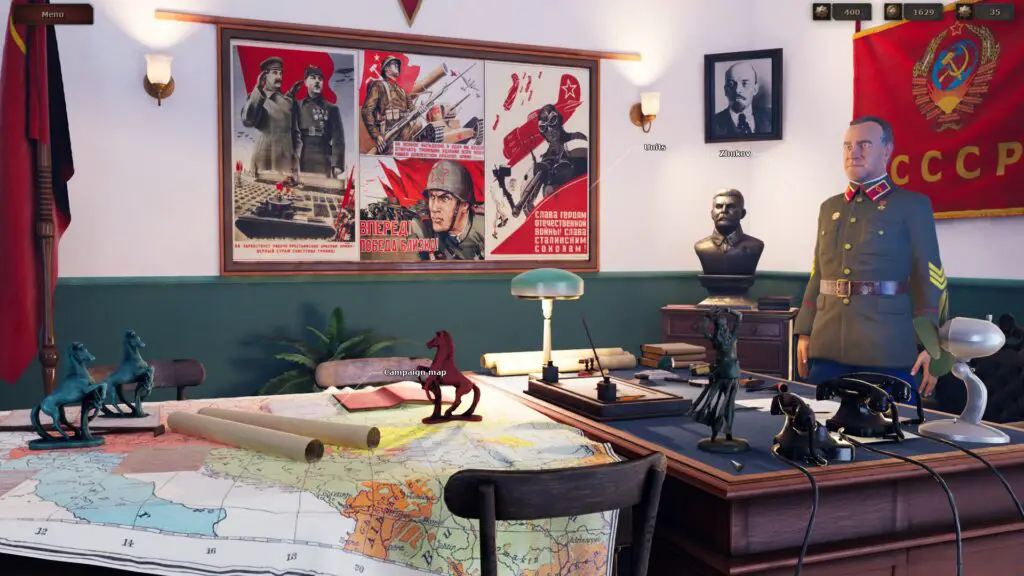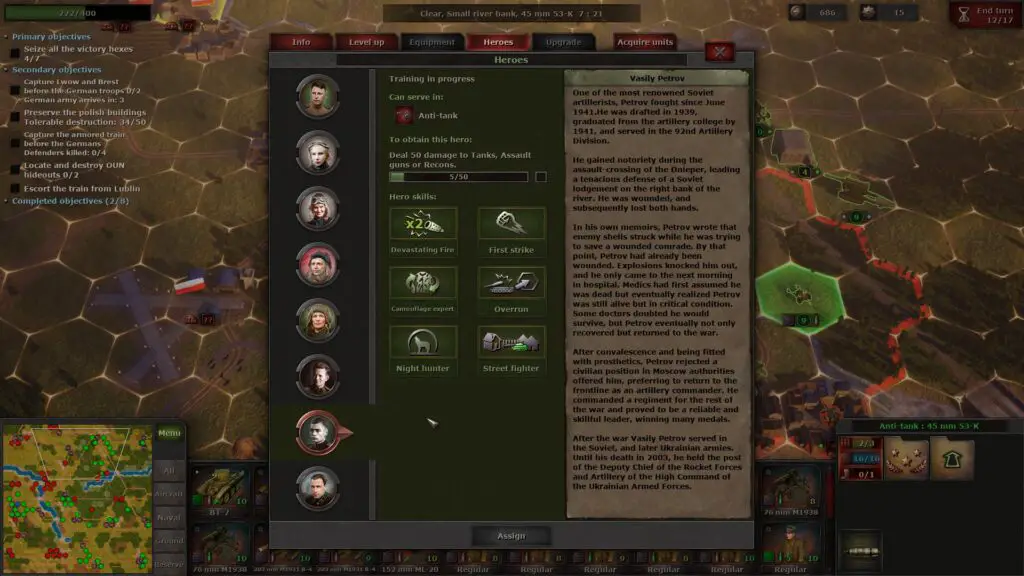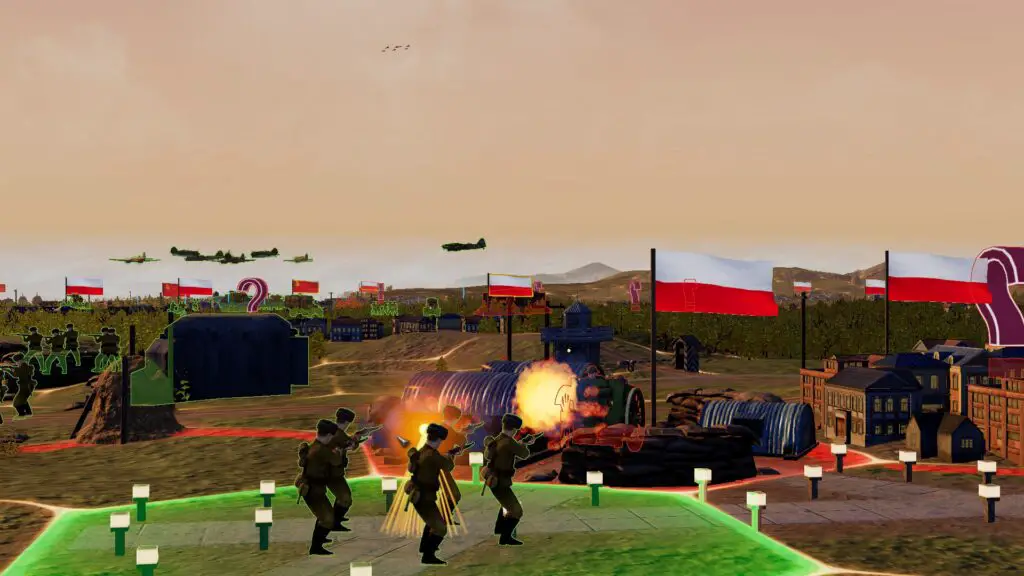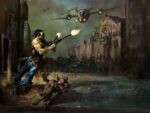WHAT TO EXPECT: WWII strategy wargame. Tactical turn-based battles. Narrative linked campaign of 20x historical battles. Cutscene briefings with voice-overs. Command a core force. RPG style army and unit customisation. A number of genuine stand-out combat mechanics. Detailed prestige reward model. HQ unit and command points Requires much more strategic planning than other games in the genre. Scenarios can feel heavily scripted and overbalanced. Some GUI ailments. Single-player only.
ACHIEVEMENTS: ORGANIC.
STATUS: COMPLETE. SUPPORT ONGOING.
WHEN TO BUY: WHEN THE PRICE IS RIGHT.

THE LOWDOWN:
Strategic Mind: Spectre of Communism (SM:SC) is the fourth in the series (including: Panzer Strategy) of turn-based strategy games depicting tactical warfare set during World War Two. In this incarnation the spectre of Communist revolution hangs above every nation around the globe. Players take on the role of a famous general who must marshal the forces of the Soviet Union on their march of conquest and domination.
Commanding a force of core and auxiliary units a range of objectives must be achieved across a twenty mission campaign. One linked by a historically narrated story and possessing a wealth of RPG style customisation elements for the player’s core forces. A series of crucial battles to fight from the era lie ahead; across every theatre of war from Mongolia in the East to Germany in the West. Before each battle commences the player is treated to a cutscene with voice-overs between various historical VIPs. These shed light on the current state of affairs defining the state of play and the personal situations these individuals find themselves in.
Once over various aspects of the core force can be configured to tailor the the player’s strategy and preferred tactical style. As objectives are met and success achieved a mix of victory, prestige and experience points are awarded to spend on a host of strategic aspects. These include; HQ skills, a core force of units and their individual equipment. In addition players can allocate heroes, assign unit skills, upgrade units to more modern versions or over-strength their numbers.

Gameplay takes place on a 3D rendered battlefield. Core units are deployed upon highly detailed hexagonal maps representing terrain, towns, cities and rivers. With roads, railways, ports and airfields used for strategic transit. Attaining objectives rewards the player with more strategic modifiers, rare equipment and an encore of prestige to spend on further upgrades and such. An abstracted supply model is used to auto-replenish unit fuel and ammo and if any replacements can be sent to damaged units.
Combat uses WEGOUGO turn sequencing and is fought mostly on land between tanks, infantry and numerous artillery types. Fighters and bombers provide ground support and air cover. At sea the odd ship sometimes provides naval support depending on the scenario. A HQ unit provides the strategic abilities such as carpet bombing and aerial reconnaissance at the cost of command points.
Among the combat concepts implemented [and there are many] are: realistic casualty preview, a heavy fog of war system, overwatch for all artillery units, two casualty types, multiple overrun action for tanks, same turn land, refuel/re-arm and take-off for aircraft, multiple air attacks on one target, equipment-based air attacks and the appearance of neutral AI controlled factions. Scenarios appear heavily scripted, contain dynamic elements and incorporate rudimentary weather patterns, into a day-day-night turn cycle. On challenging difficulty victory is never assured while a complex prestige reward system can make it feel as though it was actually a defeat.

ANALYSIS:
As a huge fan of WW2 turn-based wargames the expectation that SM:SC would turn out to be just another Panzer General II (PG2) or Panzerkorps (PzK) clone, thankfully did not materialise. Key differences in its design philosophy resulted in a welcome and varied strategy experience. So much so that apart from certain elements of tactical combat the games in question do not play the same way.
New and veteran players of tactical wargames should not make the mistake of playing SM:SC on one of the harder difficulties. They should take the time to play on an easier one to learn and get to grips with its nuances. Moreso with the abundance of interesting combat mechanics that have been incorporated into the game. One of the biggest differences was it’s pace. It was unmistakeably slower than PzK. Less of a beer and pretzel wargame in that respect. Requiring greater analysis of the battlefield before contemplating any moves. Notably becoming even more acute with a large swathe of combat mechanics not found in the other titles.
The sheer amount of unit customisation is amazing. A singularly tactical wargame morphed into one with a significant RPG presence through the allocation of equipment to certain units and the selection of skills as they levelled-up. This allowed core forces to be tinkered to the point of asserting the unit a specific role(s) in the operational plan to be executed. Thus enhancing the strategies that could be employed with it.
Introducing a HQ unit provided another welcome surprise. The ability to call upon a variety of abstracted strategic abilities using renewable command points was unexpected. Aerial reconnaissance for instance played an essential role in seeing through a multi-layer fog of war system that upped the challenge already facing this PzK veteran. Add unlockable HQ skills into the mix such as; co-operative tank attack, carpet bombing of logistic targets, purchasing unit equipment or replacements in mission and it was clear to see how much of an increase in complexity this game possessed.
Passive artillery support was expanded for anti-tank units to provide additional overwatch along with their artillery and anti-aircraft artillery cousins. This increased the need to completely reconnoitre the battlefield ahead of any movement or attack. Overrun for armoured units make a much vaunted return. Could not be stated just how much of a boon it was to deal damage to successive enemies. Even if this proved overpowered, given the hardship playing on harder difficulties that would come to pass, it was an appreciated ally in winning the battle. Another pleasing factor was the method by which entrenchment acted like a suit of armour. To be destroyed before the enemy could be damaged. Rather than being added to a stat such as the hard defence value.
The way in which air units could move to an airfield, land, refuel/rearm and take-off again meant that air-to-air combat and air-to-ground bombardment became deadlier. As was giving bombers and fighters the ability to drop their ordnance on a single unit in one given turn. Conducting concentrated bombing was something that has been missing in my wargames since, well forever. Maybe it just felt like that!
Distinguishing between lethal and non-lethal casualties was a really interesting concept. Adding a new dynamic to causing and receiving damage during combat. Together with limiting the request for replacements made capturing population centres even more vital than just liberating a victory hex.

By utilising a more complicated prestige model the developers have created a real sense of increased nuance in terms of the defining a victory or a defeat. In that gaining victory can actually seem less so, given a significant loss of prestige due to non-objective actions that cost those points. When this happened it really did feel as though the mission was a pyrrhic victory.
If all of these were not enough, the use of a day-day-night cycle added an extra level of required strategy. Either having units equipped or skilled in night-time combat or completing offensive operations before pausing every third day. Add the representation of bad weather and the dynamic of strategic concerns stack up in an obvious way.
There were some negative aspects to SM:SC. A few quirks in the GUI took some getting used to. The bright colourful graphics tended to overload the senses and needed toning down. Starting a campaign reset the auto-save settings which overloaded the hard-drive with an unwanted abundance of files. If there are bugs, they were not encountered and only a solitary crash was experienced. There did seem to be a disconnect between the display of current supply situation. Some method of showing the player what the supply area would be at the start of the next turn felt missing. This was probably related to the apparent issue where a unit was in a supply zone (hex marked with a box) but wasn’t at the start of the next turn. Even though at the end of the previous turn it had been.
Perhaps the biggest issue was an unmistakeable realisation that missions were over-scripted from the first mission onwards. Unsurprising given the franchise’s tilt towards recreating the historical context of the time. With an overloaded and unbalanced nature, mission design impacted the flow of the game at times, slowing its pace and stalling enjoyment alot unfortunately. Finding myself in such challenging situations with the need to get to grips with new mechanics force the requirement to prioritise certain objectives ahead of others. With no indication of which gave higher rewards only the very tight time-limits displayed, provided a clue as to which the player should aim for first. A situation complicated by so many hexes to conquer and a stretched force having to deal with neutral factions as well. All these kept this veteran wargamer’s hands full most of the time.
There was no doubt though that the extent of strategy and tactics portrayed in SM:SC was compelling.
Yet perhaps once a mission had been completed, subsequent replays could have incorporated some element of randomisation especially concerning the random activation of certain secondary objectives. With so many tactical and strategic aspects to its gameplay SM:SC often felt more like a puzzle to be solved stifling its enjoyment factor to a degree.








